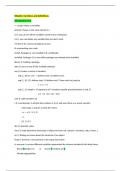Samenvatting
Summary Data Mining introduction into R + solutions exercices (introduction)
- Instelling
- Universiteit Gent (UGent)
Dit document bevat een beknopte samenvatting van alle codes die in de introductie werden behandeld. Daarnaast bevat dit document de oplossingen van de oefeningen van deze "introchapter".
[Meer zien]



